Organizational Behavior and Leadership
VerifiedAdded on 2022/11/25
|10
|2529
|87
AI Summary
This document discusses the importance of leadership in organizational behavior and outlines a personal leadership philosophy and principles. It also explores the impacts of personal beliefs and experiences on leadership approach. Additionally, it addresses a key leadership issue and proposes a solution to promote a diverse and inclusive workplace.
Contribute Materials
Your contribution can guide someone’s learning journey. Share your
documents today.
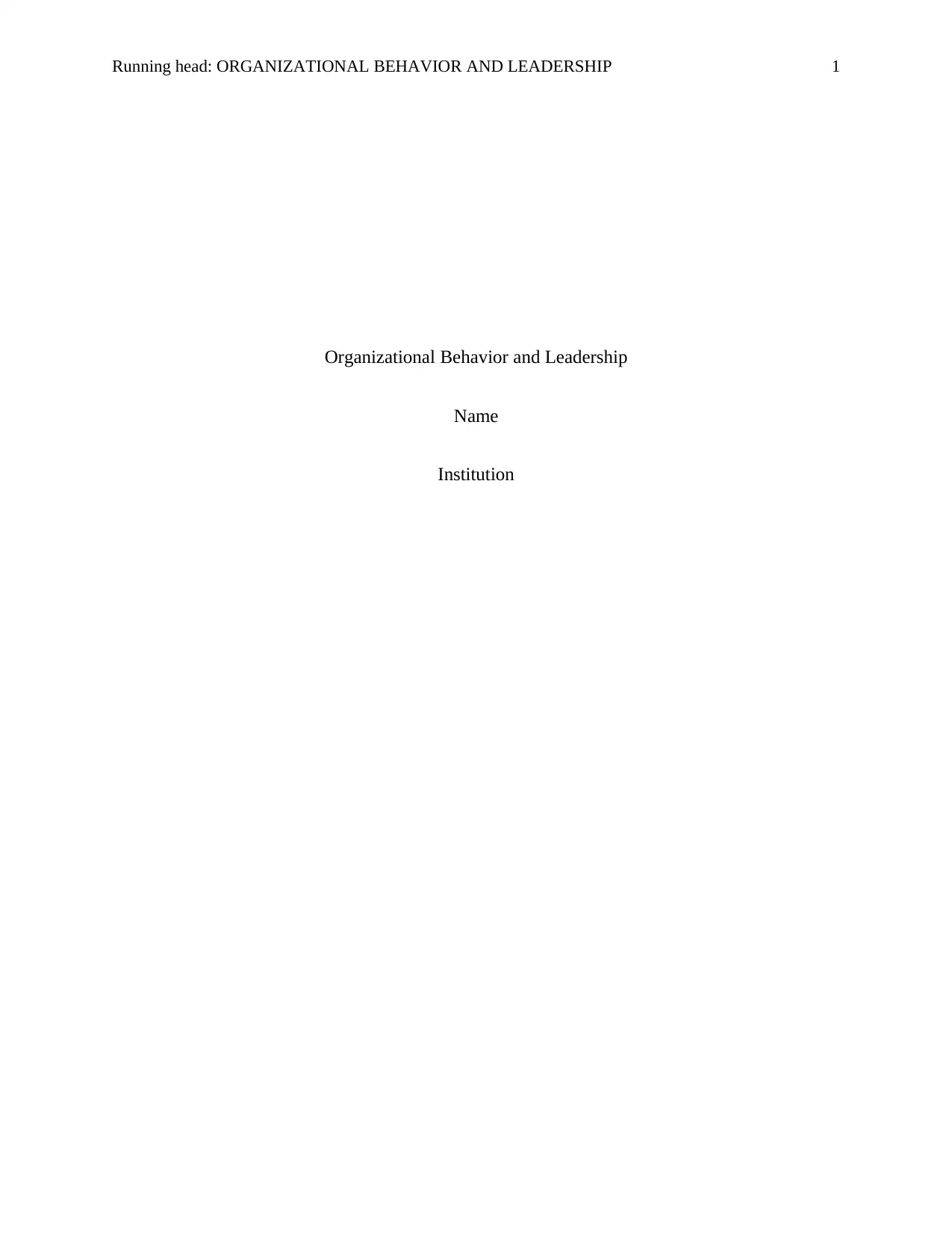
Running head: ORGANIZATIONAL BEHAVIOR AND LEADERSHIP 1
Organizational Behavior and Leadership
Name
Institution
Organizational Behavior and Leadership
Name
Institution
Secure Best Marks with AI Grader
Need help grading? Try our AI Grader for instant feedback on your assignments.
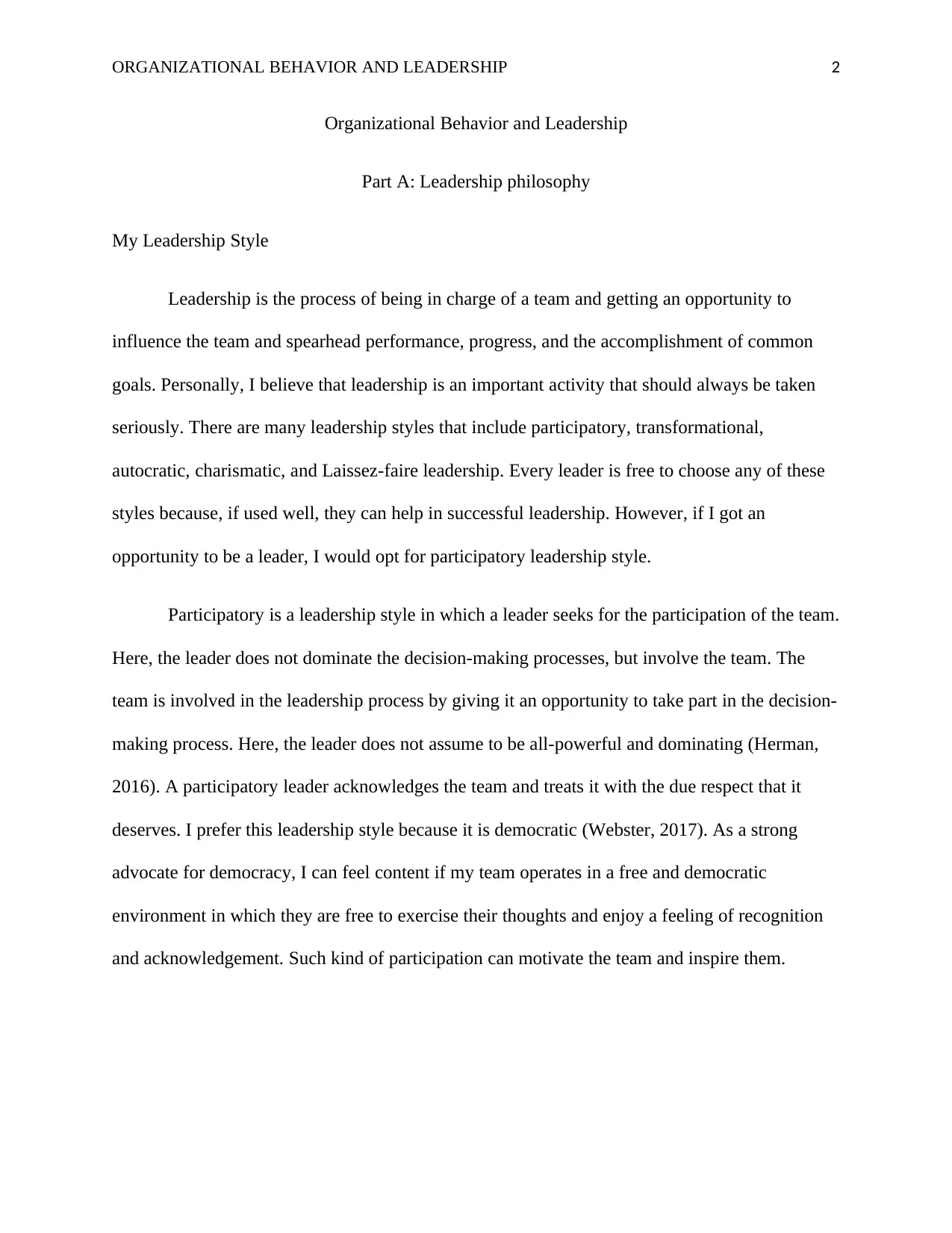
ORGANIZATIONAL BEHAVIOR AND LEADERSHIP 2
Organizational Behavior and Leadership
Part A: Leadership philosophy
My Leadership Style
Leadership is the process of being in charge of a team and getting an opportunity to
influence the team and spearhead performance, progress, and the accomplishment of common
goals. Personally, I believe that leadership is an important activity that should always be taken
seriously. There are many leadership styles that include participatory, transformational,
autocratic, charismatic, and Laissez-faire leadership. Every leader is free to choose any of these
styles because, if used well, they can help in successful leadership. However, if I got an
opportunity to be a leader, I would opt for participatory leadership style.
Participatory is a leadership style in which a leader seeks for the participation of the team.
Here, the leader does not dominate the decision-making processes, but involve the team. The
team is involved in the leadership process by giving it an opportunity to take part in the decision-
making process. Here, the leader does not assume to be all-powerful and dominating (Herman,
2016). A participatory leader acknowledges the team and treats it with the due respect that it
deserves. I prefer this leadership style because it is democratic (Webster, 2017). As a strong
advocate for democracy, I can feel content if my team operates in a free and democratic
environment in which they are free to exercise their thoughts and enjoy a feeling of recognition
and acknowledgement. Such kind of participation can motivate the team and inspire them.
Organizational Behavior and Leadership
Part A: Leadership philosophy
My Leadership Style
Leadership is the process of being in charge of a team and getting an opportunity to
influence the team and spearhead performance, progress, and the accomplishment of common
goals. Personally, I believe that leadership is an important activity that should always be taken
seriously. There are many leadership styles that include participatory, transformational,
autocratic, charismatic, and Laissez-faire leadership. Every leader is free to choose any of these
styles because, if used well, they can help in successful leadership. However, if I got an
opportunity to be a leader, I would opt for participatory leadership style.
Participatory is a leadership style in which a leader seeks for the participation of the team.
Here, the leader does not dominate the decision-making processes, but involve the team. The
team is involved in the leadership process by giving it an opportunity to take part in the decision-
making process. Here, the leader does not assume to be all-powerful and dominating (Herman,
2016). A participatory leader acknowledges the team and treats it with the due respect that it
deserves. I prefer this leadership style because it is democratic (Webster, 2017). As a strong
advocate for democracy, I can feel content if my team operates in a free and democratic
environment in which they are free to exercise their thoughts and enjoy a feeling of recognition
and acknowledgement. Such kind of participation can motivate the team and inspire them.
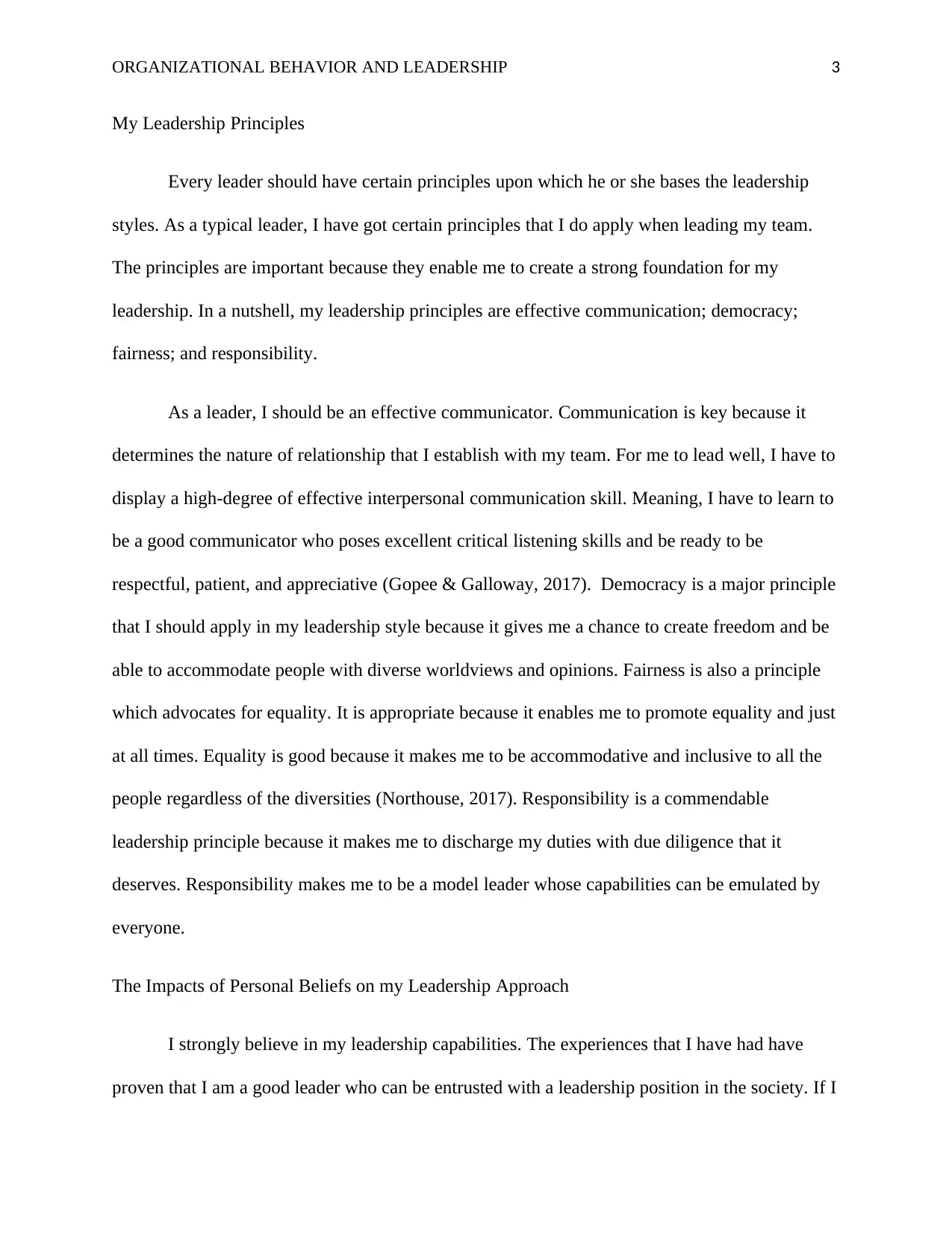
ORGANIZATIONAL BEHAVIOR AND LEADERSHIP 3
My Leadership Principles
Every leader should have certain principles upon which he or she bases the leadership
styles. As a typical leader, I have got certain principles that I do apply when leading my team.
The principles are important because they enable me to create a strong foundation for my
leadership. In a nutshell, my leadership principles are effective communication; democracy;
fairness; and responsibility.
As a leader, I should be an effective communicator. Communication is key because it
determines the nature of relationship that I establish with my team. For me to lead well, I have to
display a high-degree of effective interpersonal communication skill. Meaning, I have to learn to
be a good communicator who poses excellent critical listening skills and be ready to be
respectful, patient, and appreciative (Gopee & Galloway, 2017). Democracy is a major principle
that I should apply in my leadership style because it gives me a chance to create freedom and be
able to accommodate people with diverse worldviews and opinions. Fairness is also a principle
which advocates for equality. It is appropriate because it enables me to promote equality and just
at all times. Equality is good because it makes me to be accommodative and inclusive to all the
people regardless of the diversities (Northouse, 2017). Responsibility is a commendable
leadership principle because it makes me to discharge my duties with due diligence that it
deserves. Responsibility makes me to be a model leader whose capabilities can be emulated by
everyone.
The Impacts of Personal Beliefs on my Leadership Approach
I strongly believe in my leadership capabilities. The experiences that I have had have
proven that I am a good leader who can be entrusted with a leadership position in the society. If I
My Leadership Principles
Every leader should have certain principles upon which he or she bases the leadership
styles. As a typical leader, I have got certain principles that I do apply when leading my team.
The principles are important because they enable me to create a strong foundation for my
leadership. In a nutshell, my leadership principles are effective communication; democracy;
fairness; and responsibility.
As a leader, I should be an effective communicator. Communication is key because it
determines the nature of relationship that I establish with my team. For me to lead well, I have to
display a high-degree of effective interpersonal communication skill. Meaning, I have to learn to
be a good communicator who poses excellent critical listening skills and be ready to be
respectful, patient, and appreciative (Gopee & Galloway, 2017). Democracy is a major principle
that I should apply in my leadership style because it gives me a chance to create freedom and be
able to accommodate people with diverse worldviews and opinions. Fairness is also a principle
which advocates for equality. It is appropriate because it enables me to promote equality and just
at all times. Equality is good because it makes me to be accommodative and inclusive to all the
people regardless of the diversities (Northouse, 2017). Responsibility is a commendable
leadership principle because it makes me to discharge my duties with due diligence that it
deserves. Responsibility makes me to be a model leader whose capabilities can be emulated by
everyone.
The Impacts of Personal Beliefs on my Leadership Approach
I strongly believe in my leadership capabilities. The experiences that I have had have
proven that I am a good leader who can be entrusted with a leadership position in the society. If I
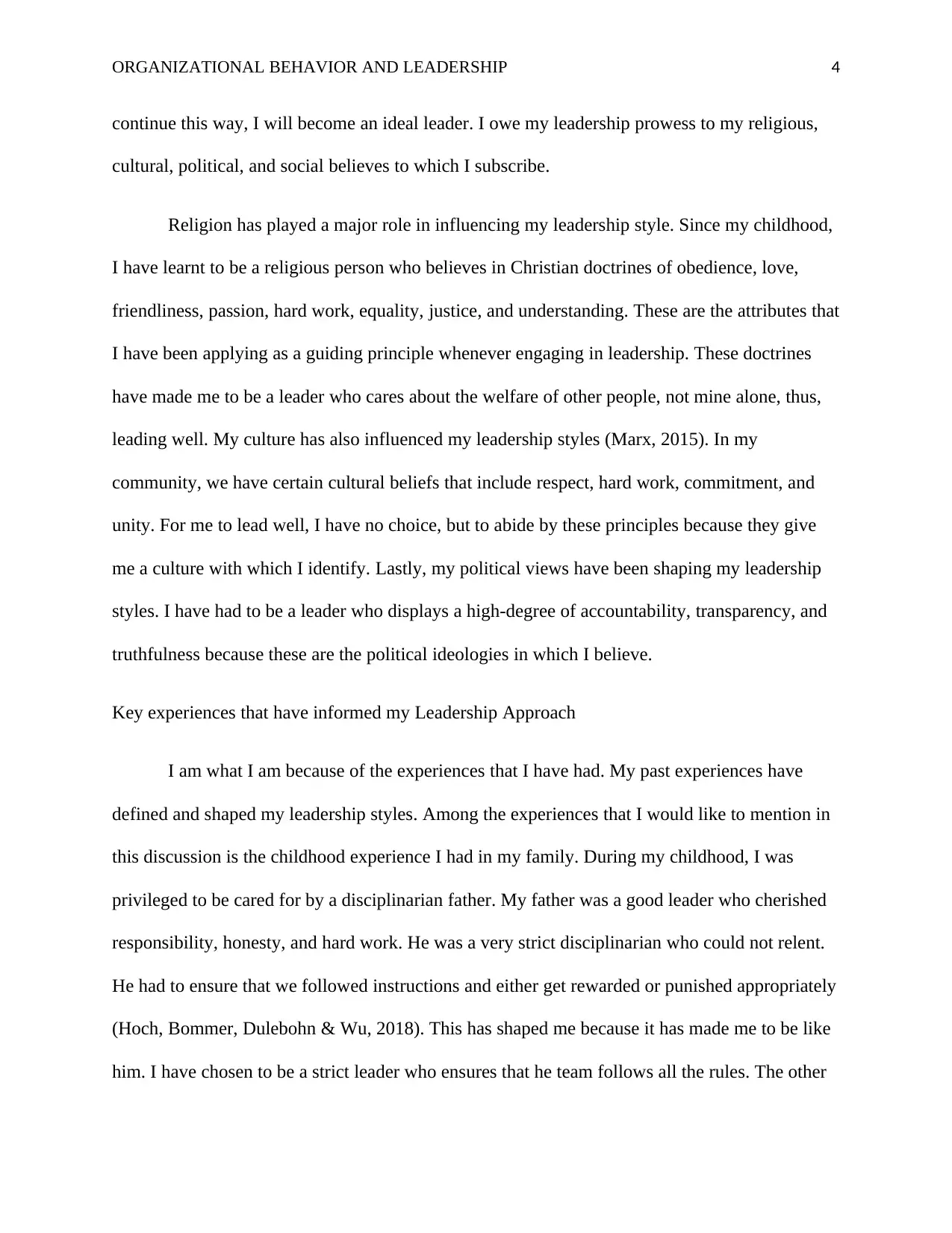
ORGANIZATIONAL BEHAVIOR AND LEADERSHIP 4
continue this way, I will become an ideal leader. I owe my leadership prowess to my religious,
cultural, political, and social believes to which I subscribe.
Religion has played a major role in influencing my leadership style. Since my childhood,
I have learnt to be a religious person who believes in Christian doctrines of obedience, love,
friendliness, passion, hard work, equality, justice, and understanding. These are the attributes that
I have been applying as a guiding principle whenever engaging in leadership. These doctrines
have made me to be a leader who cares about the welfare of other people, not mine alone, thus,
leading well. My culture has also influenced my leadership styles (Marx, 2015). In my
community, we have certain cultural beliefs that include respect, hard work, commitment, and
unity. For me to lead well, I have no choice, but to abide by these principles because they give
me a culture with which I identify. Lastly, my political views have been shaping my leadership
styles. I have had to be a leader who displays a high-degree of accountability, transparency, and
truthfulness because these are the political ideologies in which I believe.
Key experiences that have informed my Leadership Approach
I am what I am because of the experiences that I have had. My past experiences have
defined and shaped my leadership styles. Among the experiences that I would like to mention in
this discussion is the childhood experience I had in my family. During my childhood, I was
privileged to be cared for by a disciplinarian father. My father was a good leader who cherished
responsibility, honesty, and hard work. He was a very strict disciplinarian who could not relent.
He had to ensure that we followed instructions and either get rewarded or punished appropriately
(Hoch, Bommer, Dulebohn & Wu, 2018). This has shaped me because it has made me to be like
him. I have chosen to be a strict leader who ensures that he team follows all the rules. The other
continue this way, I will become an ideal leader. I owe my leadership prowess to my religious,
cultural, political, and social believes to which I subscribe.
Religion has played a major role in influencing my leadership style. Since my childhood,
I have learnt to be a religious person who believes in Christian doctrines of obedience, love,
friendliness, passion, hard work, equality, justice, and understanding. These are the attributes that
I have been applying as a guiding principle whenever engaging in leadership. These doctrines
have made me to be a leader who cares about the welfare of other people, not mine alone, thus,
leading well. My culture has also influenced my leadership styles (Marx, 2015). In my
community, we have certain cultural beliefs that include respect, hard work, commitment, and
unity. For me to lead well, I have no choice, but to abide by these principles because they give
me a culture with which I identify. Lastly, my political views have been shaping my leadership
styles. I have had to be a leader who displays a high-degree of accountability, transparency, and
truthfulness because these are the political ideologies in which I believe.
Key experiences that have informed my Leadership Approach
I am what I am because of the experiences that I have had. My past experiences have
defined and shaped my leadership styles. Among the experiences that I would like to mention in
this discussion is the childhood experience I had in my family. During my childhood, I was
privileged to be cared for by a disciplinarian father. My father was a good leader who cherished
responsibility, honesty, and hard work. He was a very strict disciplinarian who could not relent.
He had to ensure that we followed instructions and either get rewarded or punished appropriately
(Hoch, Bommer, Dulebohn & Wu, 2018). This has shaped me because it has made me to be like
him. I have chosen to be a strict leader who ensures that he team follows all the rules. The other
Secure Best Marks with AI Grader
Need help grading? Try our AI Grader for instant feedback on your assignments.
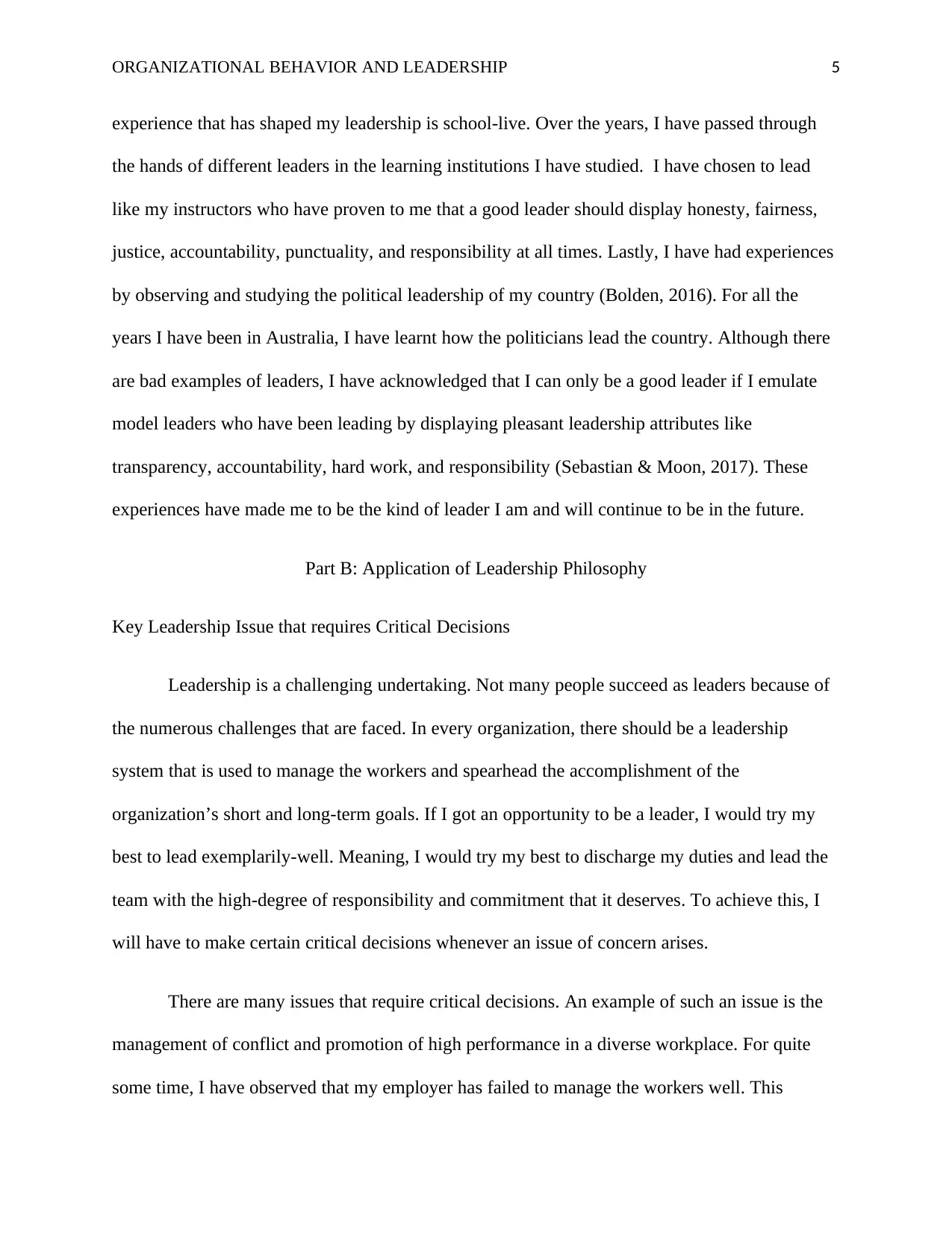
ORGANIZATIONAL BEHAVIOR AND LEADERSHIP 5
experience that has shaped my leadership is school-live. Over the years, I have passed through
the hands of different leaders in the learning institutions I have studied. I have chosen to lead
like my instructors who have proven to me that a good leader should display honesty, fairness,
justice, accountability, punctuality, and responsibility at all times. Lastly, I have had experiences
by observing and studying the political leadership of my country (Bolden, 2016). For all the
years I have been in Australia, I have learnt how the politicians lead the country. Although there
are bad examples of leaders, I have acknowledged that I can only be a good leader if I emulate
model leaders who have been leading by displaying pleasant leadership attributes like
transparency, accountability, hard work, and responsibility (Sebastian & Moon, 2017). These
experiences have made me to be the kind of leader I am and will continue to be in the future.
Part B: Application of Leadership Philosophy
Key Leadership Issue that requires Critical Decisions
Leadership is a challenging undertaking. Not many people succeed as leaders because of
the numerous challenges that are faced. In every organization, there should be a leadership
system that is used to manage the workers and spearhead the accomplishment of the
organization’s short and long-term goals. If I got an opportunity to be a leader, I would try my
best to lead exemplarily-well. Meaning, I would try my best to discharge my duties and lead the
team with the high-degree of responsibility and commitment that it deserves. To achieve this, I
will have to make certain critical decisions whenever an issue of concern arises.
There are many issues that require critical decisions. An example of such an issue is the
management of conflict and promotion of high performance in a diverse workplace. For quite
some time, I have observed that my employer has failed to manage the workers well. This
experience that has shaped my leadership is school-live. Over the years, I have passed through
the hands of different leaders in the learning institutions I have studied. I have chosen to lead
like my instructors who have proven to me that a good leader should display honesty, fairness,
justice, accountability, punctuality, and responsibility at all times. Lastly, I have had experiences
by observing and studying the political leadership of my country (Bolden, 2016). For all the
years I have been in Australia, I have learnt how the politicians lead the country. Although there
are bad examples of leaders, I have acknowledged that I can only be a good leader if I emulate
model leaders who have been leading by displaying pleasant leadership attributes like
transparency, accountability, hard work, and responsibility (Sebastian & Moon, 2017). These
experiences have made me to be the kind of leader I am and will continue to be in the future.
Part B: Application of Leadership Philosophy
Key Leadership Issue that requires Critical Decisions
Leadership is a challenging undertaking. Not many people succeed as leaders because of
the numerous challenges that are faced. In every organization, there should be a leadership
system that is used to manage the workers and spearhead the accomplishment of the
organization’s short and long-term goals. If I got an opportunity to be a leader, I would try my
best to lead exemplarily-well. Meaning, I would try my best to discharge my duties and lead the
team with the high-degree of responsibility and commitment that it deserves. To achieve this, I
will have to make certain critical decisions whenever an issue of concern arises.
There are many issues that require critical decisions. An example of such an issue is the
management of conflict and promotion of high performance in a diverse workplace. For quite
some time, I have observed that my employer has failed to manage the workers well. This
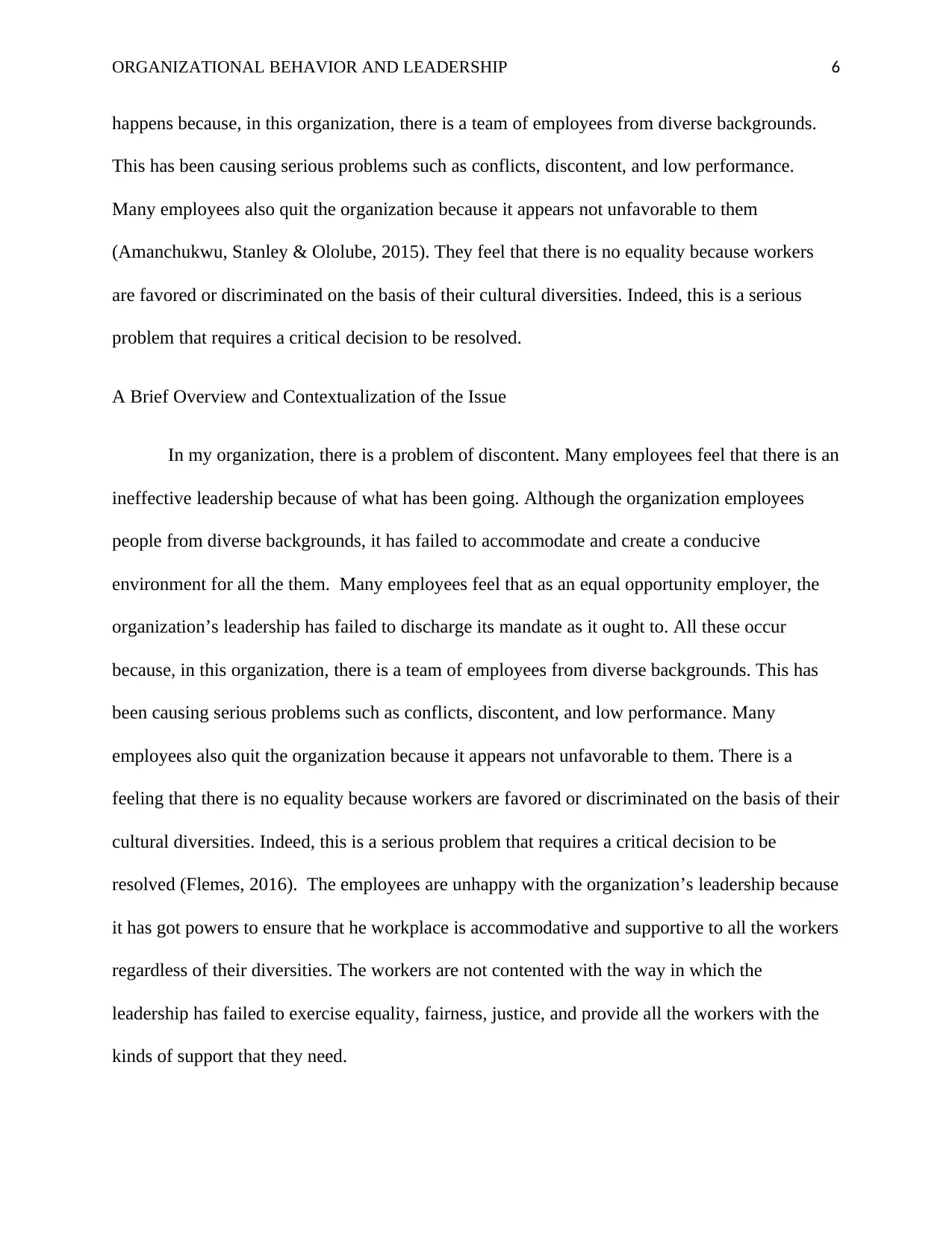
ORGANIZATIONAL BEHAVIOR AND LEADERSHIP 6
happens because, in this organization, there is a team of employees from diverse backgrounds.
This has been causing serious problems such as conflicts, discontent, and low performance.
Many employees also quit the organization because it appears not unfavorable to them
(Amanchukwu, Stanley & Ololube, 2015). They feel that there is no equality because workers
are favored or discriminated on the basis of their cultural diversities. Indeed, this is a serious
problem that requires a critical decision to be resolved.
A Brief Overview and Contextualization of the Issue
In my organization, there is a problem of discontent. Many employees feel that there is an
ineffective leadership because of what has been going. Although the organization employees
people from diverse backgrounds, it has failed to accommodate and create a conducive
environment for all the them. Many employees feel that as an equal opportunity employer, the
organization’s leadership has failed to discharge its mandate as it ought to. All these occur
because, in this organization, there is a team of employees from diverse backgrounds. This has
been causing serious problems such as conflicts, discontent, and low performance. Many
employees also quit the organization because it appears not unfavorable to them. There is a
feeling that there is no equality because workers are favored or discriminated on the basis of their
cultural diversities. Indeed, this is a serious problem that requires a critical decision to be
resolved (Flemes, 2016). The employees are unhappy with the organization’s leadership because
it has got powers to ensure that he workplace is accommodative and supportive to all the workers
regardless of their diversities. The workers are not contented with the way in which the
leadership has failed to exercise equality, fairness, justice, and provide all the workers with the
kinds of support that they need.
happens because, in this organization, there is a team of employees from diverse backgrounds.
This has been causing serious problems such as conflicts, discontent, and low performance.
Many employees also quit the organization because it appears not unfavorable to them
(Amanchukwu, Stanley & Ololube, 2015). They feel that there is no equality because workers
are favored or discriminated on the basis of their cultural diversities. Indeed, this is a serious
problem that requires a critical decision to be resolved.
A Brief Overview and Contextualization of the Issue
In my organization, there is a problem of discontent. Many employees feel that there is an
ineffective leadership because of what has been going. Although the organization employees
people from diverse backgrounds, it has failed to accommodate and create a conducive
environment for all the them. Many employees feel that as an equal opportunity employer, the
organization’s leadership has failed to discharge its mandate as it ought to. All these occur
because, in this organization, there is a team of employees from diverse backgrounds. This has
been causing serious problems such as conflicts, discontent, and low performance. Many
employees also quit the organization because it appears not unfavorable to them. There is a
feeling that there is no equality because workers are favored or discriminated on the basis of their
cultural diversities. Indeed, this is a serious problem that requires a critical decision to be
resolved (Flemes, 2016). The employees are unhappy with the organization’s leadership because
it has got powers to ensure that he workplace is accommodative and supportive to all the workers
regardless of their diversities. The workers are not contented with the way in which the
leadership has failed to exercise equality, fairness, justice, and provide all the workers with the
kinds of support that they need.
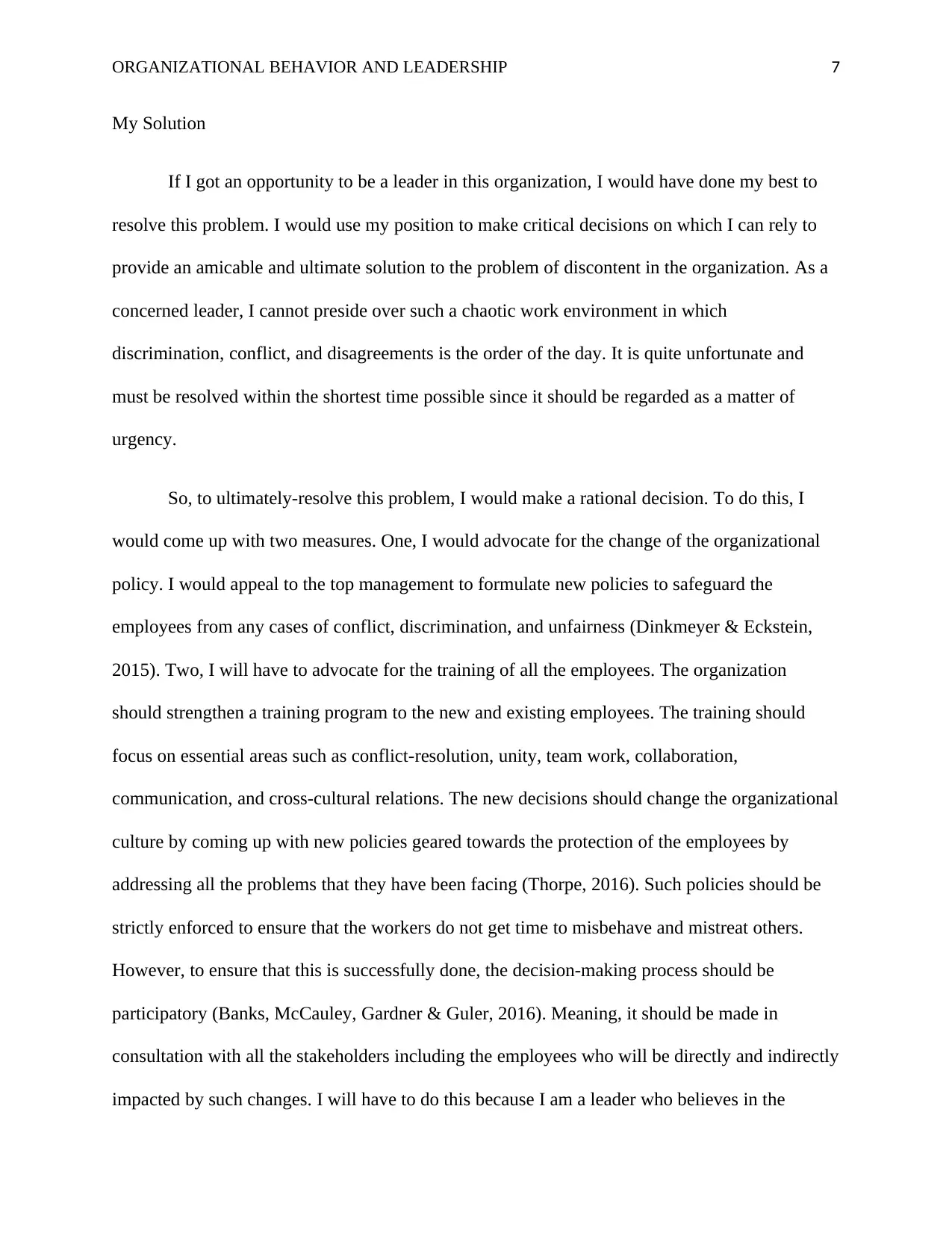
ORGANIZATIONAL BEHAVIOR AND LEADERSHIP 7
My Solution
If I got an opportunity to be a leader in this organization, I would have done my best to
resolve this problem. I would use my position to make critical decisions on which I can rely to
provide an amicable and ultimate solution to the problem of discontent in the organization. As a
concerned leader, I cannot preside over such a chaotic work environment in which
discrimination, conflict, and disagreements is the order of the day. It is quite unfortunate and
must be resolved within the shortest time possible since it should be regarded as a matter of
urgency.
So, to ultimately-resolve this problem, I would make a rational decision. To do this, I
would come up with two measures. One, I would advocate for the change of the organizational
policy. I would appeal to the top management to formulate new policies to safeguard the
employees from any cases of conflict, discrimination, and unfairness (Dinkmeyer & Eckstein,
2015). Two, I will have to advocate for the training of all the employees. The organization
should strengthen a training program to the new and existing employees. The training should
focus on essential areas such as conflict-resolution, unity, team work, collaboration,
communication, and cross-cultural relations. The new decisions should change the organizational
culture by coming up with new policies geared towards the protection of the employees by
addressing all the problems that they have been facing (Thorpe, 2016). Such policies should be
strictly enforced to ensure that the workers do not get time to misbehave and mistreat others.
However, to ensure that this is successfully done, the decision-making process should be
participatory (Banks, McCauley, Gardner & Guler, 2016). Meaning, it should be made in
consultation with all the stakeholders including the employees who will be directly and indirectly
impacted by such changes. I will have to do this because I am a leader who believes in the
My Solution
If I got an opportunity to be a leader in this organization, I would have done my best to
resolve this problem. I would use my position to make critical decisions on which I can rely to
provide an amicable and ultimate solution to the problem of discontent in the organization. As a
concerned leader, I cannot preside over such a chaotic work environment in which
discrimination, conflict, and disagreements is the order of the day. It is quite unfortunate and
must be resolved within the shortest time possible since it should be regarded as a matter of
urgency.
So, to ultimately-resolve this problem, I would make a rational decision. To do this, I
would come up with two measures. One, I would advocate for the change of the organizational
policy. I would appeal to the top management to formulate new policies to safeguard the
employees from any cases of conflict, discrimination, and unfairness (Dinkmeyer & Eckstein,
2015). Two, I will have to advocate for the training of all the employees. The organization
should strengthen a training program to the new and existing employees. The training should
focus on essential areas such as conflict-resolution, unity, team work, collaboration,
communication, and cross-cultural relations. The new decisions should change the organizational
culture by coming up with new policies geared towards the protection of the employees by
addressing all the problems that they have been facing (Thorpe, 2016). Such policies should be
strictly enforced to ensure that the workers do not get time to misbehave and mistreat others.
However, to ensure that this is successfully done, the decision-making process should be
participatory (Banks, McCauley, Gardner & Guler, 2016). Meaning, it should be made in
consultation with all the stakeholders including the employees who will be directly and indirectly
impacted by such changes. I will have to do this because I am a leader who believes in the
Paraphrase This Document
Need a fresh take? Get an instant paraphrase of this document with our AI Paraphraser
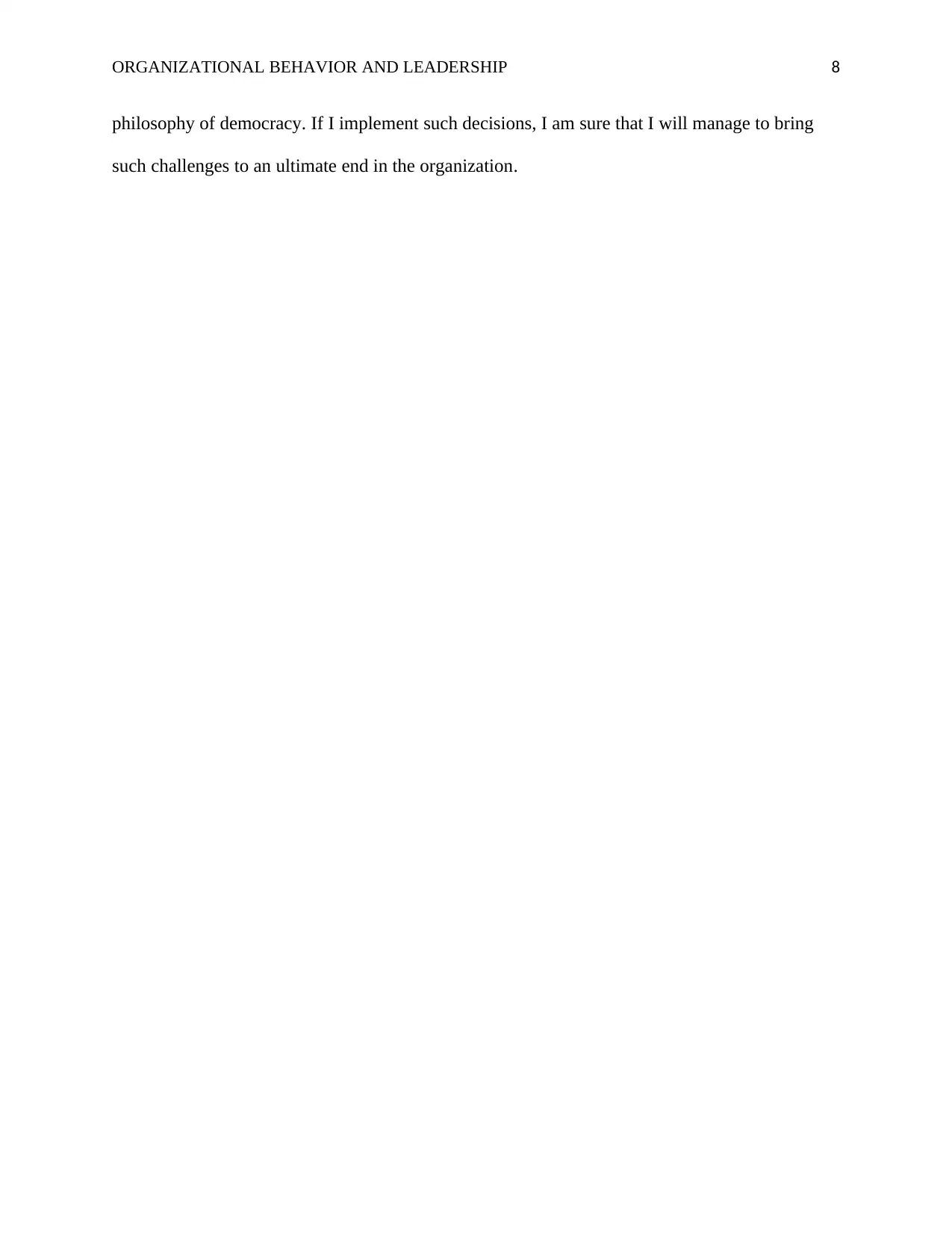
ORGANIZATIONAL BEHAVIOR AND LEADERSHIP 8
philosophy of democracy. If I implement such decisions, I am sure that I will manage to bring
such challenges to an ultimate end in the organization.
philosophy of democracy. If I implement such decisions, I am sure that I will manage to bring
such challenges to an ultimate end in the organization.
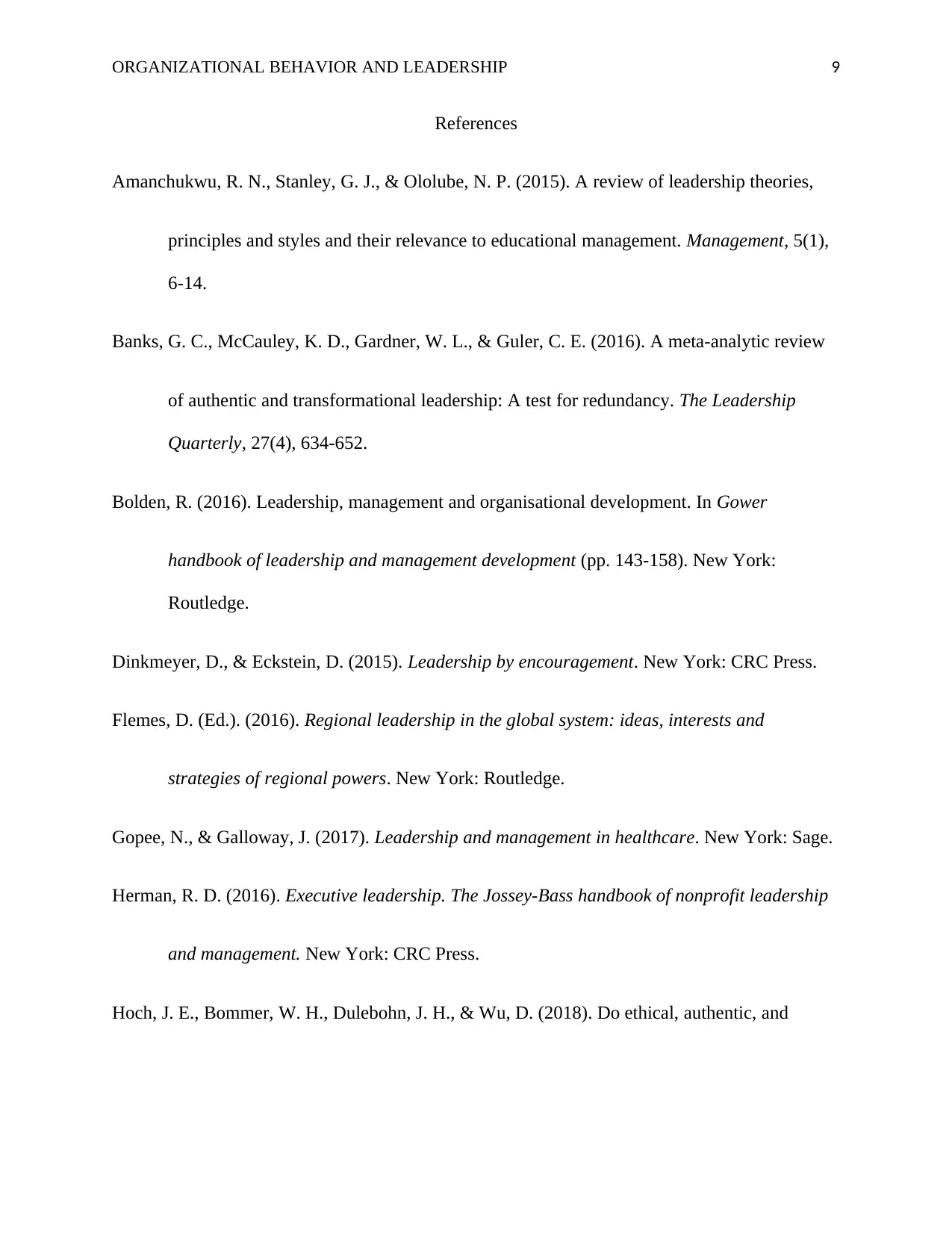
ORGANIZATIONAL BEHAVIOR AND LEADERSHIP 9
References
Amanchukwu, R. N., Stanley, G. J., & Ololube, N. P. (2015). A review of leadership theories,
principles and styles and their relevance to educational management. Management, 5(1),
6-14.
Banks, G. C., McCauley, K. D., Gardner, W. L., & Guler, C. E. (2016). A meta-analytic review
of authentic and transformational leadership: A test for redundancy. The Leadership
Quarterly, 27(4), 634-652.
Bolden, R. (2016). Leadership, management and organisational development. In Gower
handbook of leadership and management development (pp. 143-158). New York:
Routledge.
Dinkmeyer, D., & Eckstein, D. (2015). Leadership by encouragement. New York: CRC Press.
Flemes, D. (Ed.). (2016). Regional leadership in the global system: ideas, interests and
strategies of regional powers. New York: Routledge.
Gopee, N., & Galloway, J. (2017). Leadership and management in healthcare. New York: Sage.
Herman, R. D. (2016). Executive leadership. The Jossey-Bass handbook of nonprofit leadership
and management. New York: CRC Press.
Hoch, J. E., Bommer, W. H., Dulebohn, J. H., & Wu, D. (2018). Do ethical, authentic, and
References
Amanchukwu, R. N., Stanley, G. J., & Ololube, N. P. (2015). A review of leadership theories,
principles and styles and their relevance to educational management. Management, 5(1),
6-14.
Banks, G. C., McCauley, K. D., Gardner, W. L., & Guler, C. E. (2016). A meta-analytic review
of authentic and transformational leadership: A test for redundancy. The Leadership
Quarterly, 27(4), 634-652.
Bolden, R. (2016). Leadership, management and organisational development. In Gower
handbook of leadership and management development (pp. 143-158). New York:
Routledge.
Dinkmeyer, D., & Eckstein, D. (2015). Leadership by encouragement. New York: CRC Press.
Flemes, D. (Ed.). (2016). Regional leadership in the global system: ideas, interests and
strategies of regional powers. New York: Routledge.
Gopee, N., & Galloway, J. (2017). Leadership and management in healthcare. New York: Sage.
Herman, R. D. (2016). Executive leadership. The Jossey-Bass handbook of nonprofit leadership
and management. New York: CRC Press.
Hoch, J. E., Bommer, W. H., Dulebohn, J. H., & Wu, D. (2018). Do ethical, authentic, and
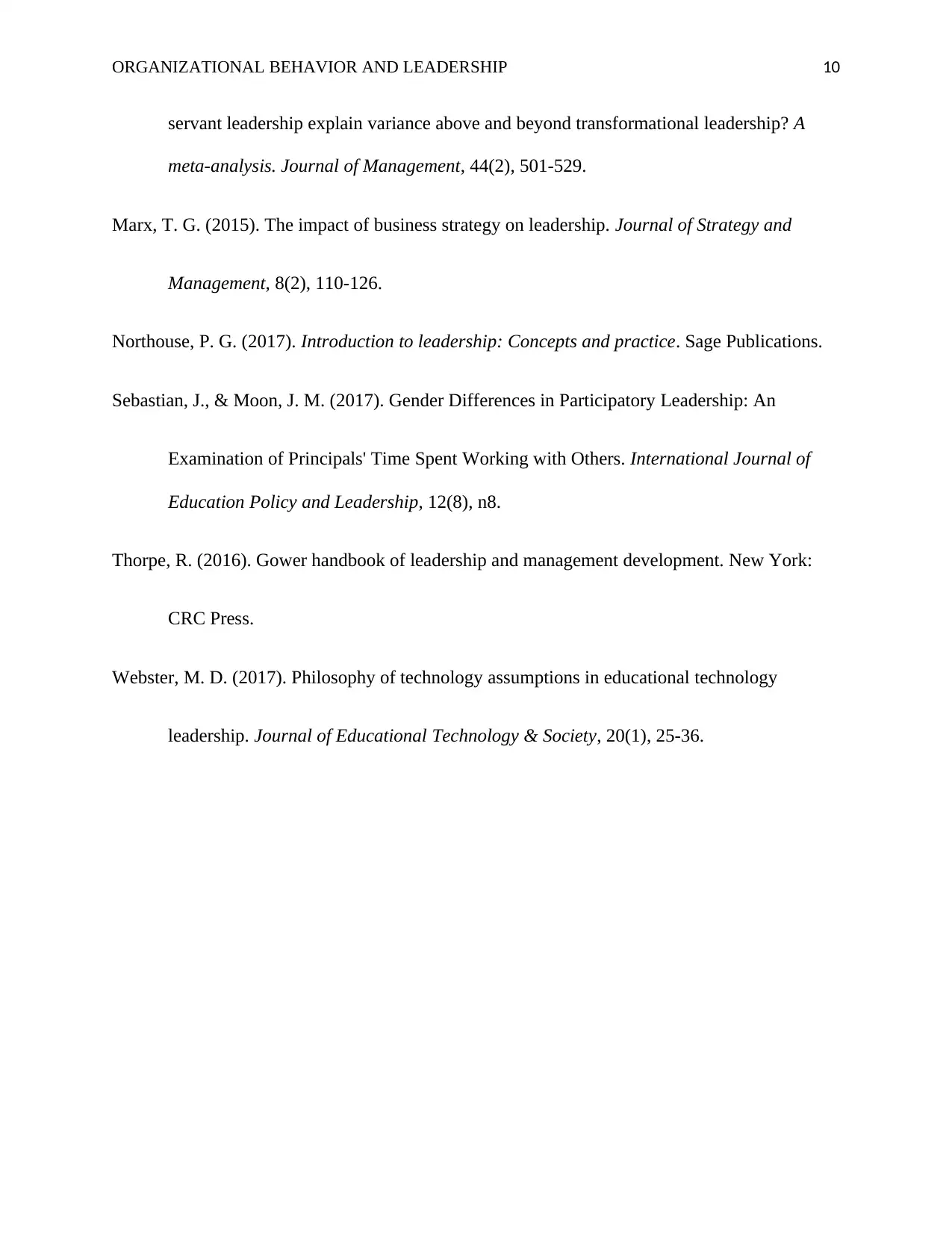
ORGANIZATIONAL BEHAVIOR AND LEADERSHIP 10
servant leadership explain variance above and beyond transformational leadership? A
meta-analysis. Journal of Management, 44(2), 501-529.
Marx, T. G. (2015). The impact of business strategy on leadership. Journal of Strategy and
Management, 8(2), 110-126.
Northouse, P. G. (2017). Introduction to leadership: Concepts and practice. Sage Publications.
Sebastian, J., & Moon, J. M. (2017). Gender Differences in Participatory Leadership: An
Examination of Principals' Time Spent Working with Others. International Journal of
Education Policy and Leadership, 12(8), n8.
Thorpe, R. (2016). Gower handbook of leadership and management development. New York:
CRC Press.
Webster, M. D. (2017). Philosophy of technology assumptions in educational technology
leadership. Journal of Educational Technology & Society, 20(1), 25-36.
servant leadership explain variance above and beyond transformational leadership? A
meta-analysis. Journal of Management, 44(2), 501-529.
Marx, T. G. (2015). The impact of business strategy on leadership. Journal of Strategy and
Management, 8(2), 110-126.
Northouse, P. G. (2017). Introduction to leadership: Concepts and practice. Sage Publications.
Sebastian, J., & Moon, J. M. (2017). Gender Differences in Participatory Leadership: An
Examination of Principals' Time Spent Working with Others. International Journal of
Education Policy and Leadership, 12(8), n8.
Thorpe, R. (2016). Gower handbook of leadership and management development. New York:
CRC Press.
Webster, M. D. (2017). Philosophy of technology assumptions in educational technology
leadership. Journal of Educational Technology & Society, 20(1), 25-36.
1 out of 10
Related Documents
Your All-in-One AI-Powered Toolkit for Academic Success.
+13062052269
info@desklib.com
Available 24*7 on WhatsApp / Email
![[object Object]](/_next/static/media/star-bottom.7253800d.svg)
Unlock your academic potential
© 2024 | Zucol Services PVT LTD | All rights reserved.




